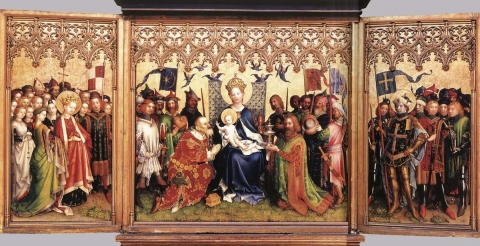
State, Religion, and Church – the leading Russian language academic quarterly in religious studies – Invites authors to submit their papers for a special issue on the role of the cults of the saints in the formation of national and local identities from the Middle Ages to the Modern period. The special theme of this volume will deal with cases from North and Central-Eastern Europe (No. 1, 2003).
The images of saints were an important guideline in the formation of Christian identity, the sense of “being Christian”. The pantheon of the saints helped to form the Pax Christiana. The inclusion of new territories was marked by the spread of the cult of saints; worshipping them meant belonging to a global community of fellow believers. Local cults played an important role for local identities associated with towns, villages, and other localities: it produced a kind of medieval social networks. These networks could include spiritual/religious organizations: fraternities, monastic and chivalric orders, clergy of churches and church communities created around them.
In Modern times, during the era of national romanticism, some saints acquired the status of national heroes. They turned out to be symbolic figures in whom crucially important images of local, ethno-cultural and later national discourse were embodied, making possible the very emergence of nations as 'imagined communities' as defined by Benedict Anderson. The images of medieval legends were transformed into cultural memory and became "figures of recognition" in the national discourses of Modern times. This special issue will explore the reasons that allowed the cults of saints and heroes to remain relevant for the Modern era, while a comparative analysis of various cases will help explaining the differences in contemporary political culture.
In this issue, the specific region chosen for the issue’s theme will be the Baltic Sea, a melting pot of identities, cultures, and peoples (Baltic States, Scandinavia, Northern Germany, Poland, Northern Belorussia, and Northwest Russia). Here a few nations and national states emerged; here the empires were born and died. All Christian confessions were represented here. Religious, ethno-cultural, and later national identities were shaped. Norbert Goetz very aptly named the Baltic Sea – the “Sea of Identities.”
The following questions are at the core of this issue:
- What was the role of the cults of common and local saints in shaping identities and social relations in the Middle Ages and in Modern times?
- What made a medieval saint suitable for the role of a hero in Modern times?
- Why was it important to construct the lines of identity through images of saints from modern times to the Middle Ages?
- What in the symbolic stories remained from the Middle Ages and what came from the modern imagination?
Please send abstracts (300-500 words) in any language and CV to the address of the editorial board (religion@ranepa.ru) and guest editor Alexander Filyushkin (a.filushkin@spbu.ru) until November 1, 2021. If the proposal is successful, papers of approximately 7000 words should be sent to the editorial board by March 30, 2022.

